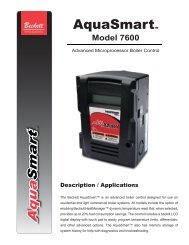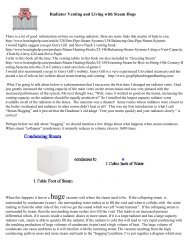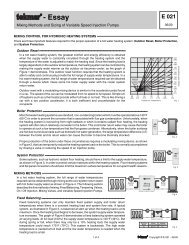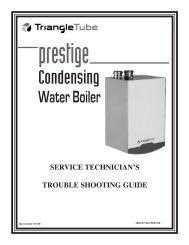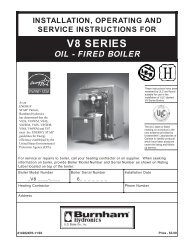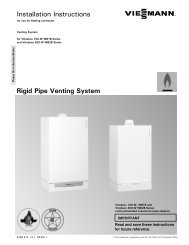Steam Locomotive Firebox Explosion on the Gettysburg Railroad ...
Steam Locomotive Firebox Explosion on the Gettysburg Railroad ...
Steam Locomotive Firebox Explosion on the Gettysburg Railroad ...
You also want an ePaper? Increase the reach of your titles
YUMPU automatically turns print PDFs into web optimized ePapers that Google loves.
(a false head) above <strong>the</strong> crownsheet rear<br />
where <strong>the</strong> gage cocks are installed.<br />
Depending up<strong>on</strong> <strong>the</strong> placement and<br />
length of <strong>the</strong> pipes leading from <strong>the</strong> gage<br />
cocks into <strong>the</strong> boiler, <strong>the</strong> false head may<br />
cause <strong>the</strong> gage cocks to indicate that <strong>the</strong><br />
water level over <strong>the</strong> crownsheet is higher<br />
than it actually is. Thus, while <strong>the</strong> gage<br />
cocks may indicate plenty of water, in reality<br />
<strong>the</strong>re may be little or no water over <strong>the</strong><br />
crownsheet. C<strong>on</strong>sequently, gage cocks are<br />
problematic when used by <strong>the</strong>mselves and<br />
questi<strong>on</strong>able as l<strong>on</strong>g-term redundant devices<br />
for a water glass. Because of this<br />
documented phenomen<strong>on</strong>, <strong>the</strong> United States<br />
<strong>Railroad</strong> Administrati<strong>on</strong>’s Committee <strong>on</strong><br />
Standards adopted <strong>the</strong> water column as a<br />
recommended practice in February 1920.<br />
The water column is a small cylindrical<br />
device that is c<strong>on</strong>nected to <strong>the</strong> boiler in<br />
much <strong>the</strong> same fashi<strong>on</strong> as a water glass;<br />
however, <strong>the</strong> water column is really a<br />
platform <strong>on</strong> which to mount a water glass<br />
and three gage cocks. (See figures 15 and<br />
16.) The water column has a limited<br />
dampening effect and prevents <strong>the</strong> high level<br />
of water (false head) in <strong>the</strong> back of <strong>the</strong> boiler<br />
from being falsely indicated by <strong>the</strong> gage<br />
cocks as <strong>the</strong> true water level. This<br />
arrangement ensures that <strong>the</strong> water glass and<br />
<strong>the</strong> gage cocks indicate <strong>the</strong> same and a true<br />
water level.<br />
<str<strong>on</strong>g>Steam</str<strong>on</strong>g>-locomotive maintenance literature<br />
states that maintenance has a significant effect<br />
<strong>on</strong> water-m<strong>on</strong>itoring devices, particularly<br />
<strong>the</strong> water glass. If <strong>the</strong> spindles that lead<br />
from <strong>the</strong> boiler to <strong>the</strong> water-m<strong>on</strong>itoring devices<br />
are not clean, <strong>the</strong> water-level indicati<strong>on</strong><br />
may be false. When steam locomotives<br />
were in comm<strong>on</strong> use, <strong>the</strong> standard practice<br />
was to clean <strong>the</strong> interior of <strong>the</strong> spindles,<br />
water glass/water column body, gage cocks,<br />
and associated piping of scale with a reamer<br />
or drill sized to fit <strong>the</strong> interior diameter of<br />
<strong>the</strong> pipe or comp<strong>on</strong>ent. The reaming restored<br />
<strong>the</strong> parts to <strong>the</strong>ir original c<strong>on</strong>diti<strong>on</strong>.<br />
FRA regulati<strong>on</strong>s imply that unless <strong>the</strong><br />
gage-cock pipes are periodically cleaned, <strong>the</strong><br />
pipes may become so plugged by scale that<br />
water is unable to pass through <strong>the</strong>m and <strong>the</strong><br />
gage cocks, as a result, might inaccurately<br />
indicate a low level of water in <strong>the</strong> boiler. At<br />
first, it might seem that indicating that <strong>the</strong><br />
water level is lower than it actually is would<br />
not be a problem. If <strong>the</strong> enginecrew thought<br />
that <strong>the</strong>re was less water in <strong>the</strong> boiler than<br />
<strong>the</strong>re actually was, <strong>the</strong>y might increase <strong>the</strong><br />
water flow to a boiler that already had<br />
enough water. Raising <strong>the</strong> level of water in<br />
<strong>the</strong> boiler unnecessarily is not necessarily<br />
dangerous, but it is not efficient and could<br />
increase <strong>the</strong> chance of incompressible water<br />
entering a cylinder (called “working water”<br />
31 ) and causing a cylinder head to be<br />
blown off.<br />
When water-glass spindles become<br />
progressively encrusted with scale, unpredictable<br />
and unreliable indicati<strong>on</strong>s may<br />
result. As moving water at <strong>the</strong> boiler<br />
backhead moves past <strong>on</strong>e or both spindle<br />
orifices of <strong>the</strong> water glass, a slight pressure<br />
drop is created. Normally, this has little or<br />
no effect <strong>on</strong> <strong>the</strong> height of <strong>the</strong> column of<br />
water in <strong>the</strong> water glass; however, should<br />
<strong>on</strong>e or both spindle orifices become partially<br />
closed off by <strong>the</strong> gradual buildup of scale,<br />
<strong>the</strong> height of <strong>the</strong> column of water in <strong>the</strong><br />
water glass may be affected, depending <strong>on</strong><br />
<strong>the</strong> locati<strong>on</strong> and extent of <strong>the</strong> buildup.<br />
53 5KPEG"YCVGT"KU"CP"KPEQORTGUUKDNG"NKSWKF."CP["YCVGT<br />
VJCV" OKIJV" GPVGT" VJG" E[NKPFGTU" OKIJV" FCOCIG" VJG<br />
E[NKPFGTU"QT"DGPF"C"FTKXG"TQF0<br />
27



